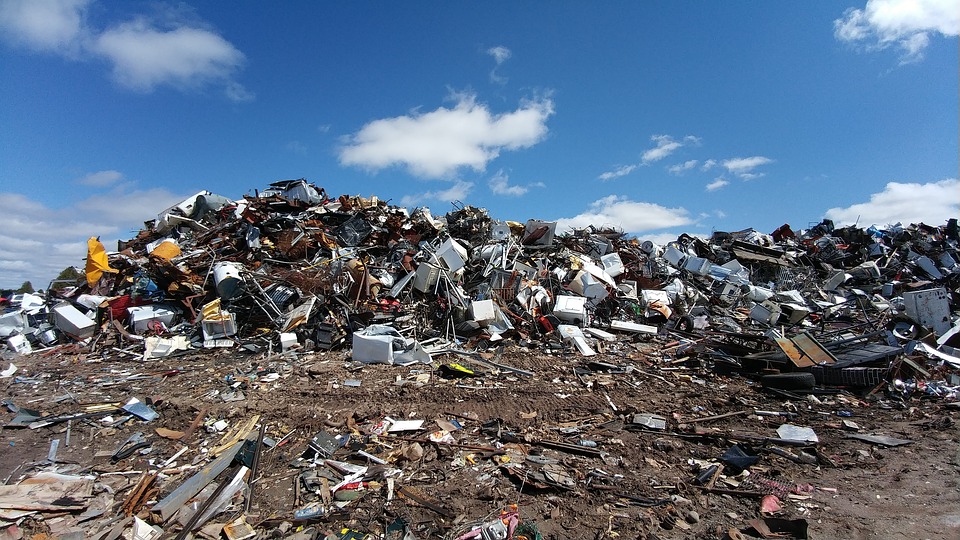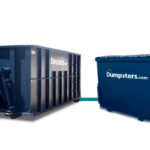The majority of that trash gets compacted into landfill waste, then it’s often bulldozed and buried – and there it sits.
Meanwhile, it breaks down, rots, and leaks chemicals into the soil it’s sitting on and it builds up.
The average American produces more than 4 pounds of trash per day.
Where are the landfills in our state and all the others?
Are they open or closed? What kind of trash do they accept? Does our trash stay in our own states, or does it get trucked to somewhere else – and why?
All told, trash disposal is a much more complicated process than one might think.
Here is some interesting info we found out:
- The amount of trash going into the country’s landfills is at its lowest level since 1960.
- Food waste, plastics, and paper products make up more than half the garbage in U.S. landfills.
- Michigan is the state with the most trash per capita, with Indiana and Illinois ranking second and third.
- Indiana’s landfills are growing the fastest in the nation.
California has more landfills than any other state in the nation – more than twice as many, in fact, as every other state except Texas.
The things we throw away (and how we do it) can tell us so much about ourselves as a people.
What we keep, what we throw out, how much thought we give to the process, whether – and how – we can try to make it better.
So let’s get our hands dirty by digging into more facts about the nation’s trash.
Where Does The Trash Go?
A lot of the trash we produce goes into landfill waste.
But the good news is that the annual amount of trash deposited in landfills has actually fallen through the years.
Even though the total amount of waste we produce has increased over the past three generations, the amount of trash going into landfills today is at its lowest level since 1960.
America is currently landfilling 2.3 pounds of waste per person daily, whereas in 1960, the rate was 2.5 pounds per person daily.
Recycling, burning, and composting are helping restrict landfill growth, especially with curbside programs and cash-back initiatives.
In California, for instance, consumers pay an extra 5 – 10 cents for a drink.
Depending on the size of each beverage container they purchase, they get a refund when they drop off the plastic at recycling centers.
Californians have recycled more than 300 billion aluminum, glass, and plastic containers since the program started in 1987.
And the Golden State isn’t alone: A total of 1.2 billion aluminum cans were collected and recycled across the United States in 1972, a figure which rose to 62 billion cans recycled by 1995.
However, there are still no nationwide recycling requirements, and only 22 U.S. states have mandatory recycling laws. So the problem isn’t solved – far from it.
Who Has The Most Trash?
Decades worth of trash is buried in landfills across the country, and some of it has been shipped from one state to another.
Learning this strange fact led us to wonder: Which states contain the most trash in landfills per capita?
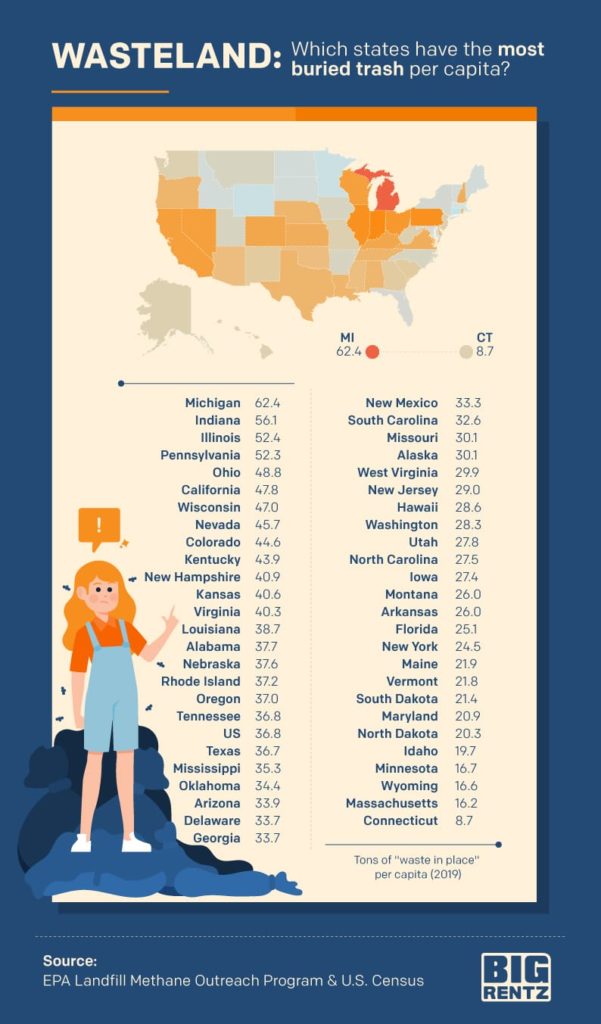
Upper Midwestern and eastern industrial states especially have racked up a lot of trash over the years.
Michigan, Indiana, Illinois, Pennsylvania, and Ohio take the top five spots on the trash-per-capita list.
More sparsely populated states such as Wyoming, Idaho, Maine, Vermont, and North and South Dakota, all rank with the least landfill trash per resident.
Michigan has the most accumulated waste per person, with a staggering 62.4 tons of buried waste for every person in the state.
Indiana and Illinois rank second and third, with 56.1 and 52.4 tons of trash per capita, respectively.
Largely because it accepts considerably less trash by volume than most other states, Connecticut hosts the least buried trash per person, with only 8.7 tons per resident.
Massachusetts (16.2 tons) and Wyoming (16.6 tons) rank second and third least landfilled, respectively.
How Many Landfills Are There?
How many landfills are there across the United States?
There are currently 2,622 landfills in existence; of those, 1,304 are open and operating.
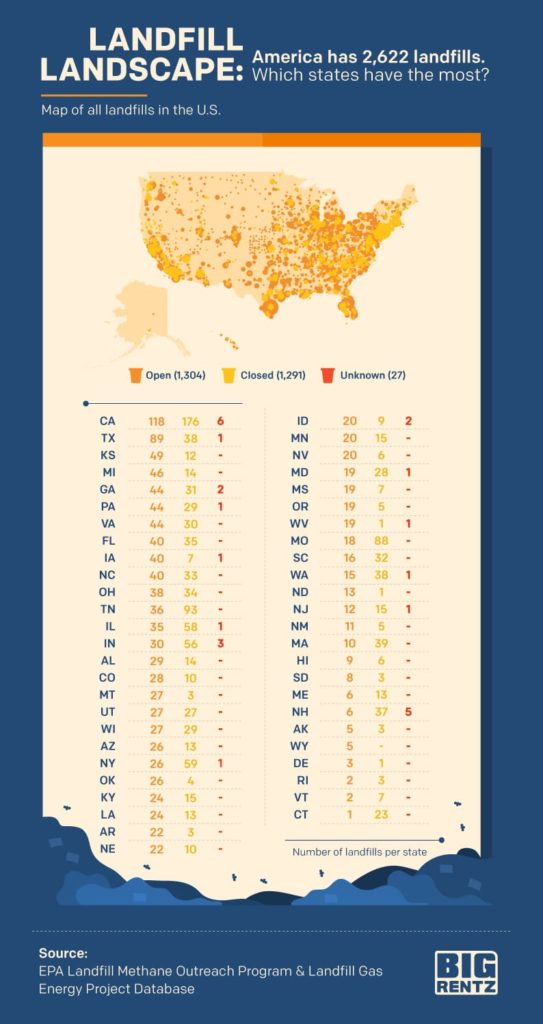
California, Texas, and Kansas have the most operating landfills, rankings which partially correspond with the states’ relative size and populations.
California, with 118 working landfills, has more than twice as many as any other state, except for second-ranked Texas.
The Golden State also has by far the most closed landfills, 176 in total.
Significantly smaller states Connecticut, Vermont, and Rhode Island have the fewest operating landfills.
Almost all of Connecticut’s landfills have been closed.
Who Owns Our Landfills?
Although local governments still own most of the country’s landfills (1,669 out of 2,622), about one-third of landfills today are privately owned (860 out of 2,622).
Others are operated as public/private partnerships.
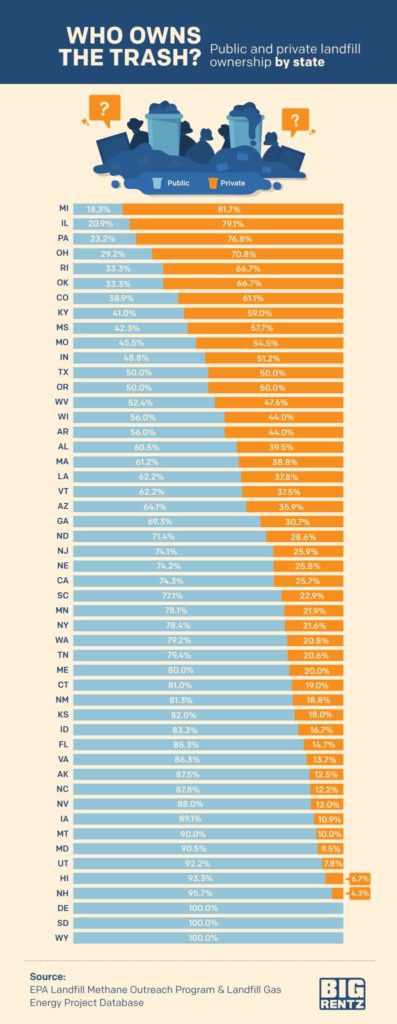
Michigan leads the nation with the greatest percentage of privatized landfills (81.7%), followed by Illinois (79.1%) and Pennsylvania (76.8%).
Wyoming, South Dakota, and Delaware do not house any private landfills.
New Hampshire, Hawaii, and Utah have the lowest percentages of private landfills in the country.
Regardless of ownership type, all landfills in the U.S. are monitored by the Environmental Protection Agency.
According to one estimate, private industry controlled 85-90% of permitted landfill capacity as of 2018, a sharp rise from 36% in 1998, and just 17% in 1984.
Private companies have better access to private funding and can benefit from economies of scale.
And they have plenty of incentive to get involved.
Private landfills are big business: Five publicly traded companies ran 542 active landfills in North America as of March 2019.
The biggest of the firms, Waste Management, ran 247 solid-waste landfills and five more for hazardous waste, employing 43,700 workers.
To Conclude.
The average American produces more than 4 pounds of trash per day.
The Environmental Protection Agency has been monitoring landfill waste and reporting data about the national waste stream for more than 30 years.
All landfills, whether they are publicly or privately owned, are monitored as part of an effort to protect groundwater and track heat-trapping methane emissions.
In conclusion, landfill waste is an important part of our society, but the question is, what can we do to minimize the effects of our garbage that we throw away every day?
Credit: American Wasteland: Which States Produce the Most Trash?

